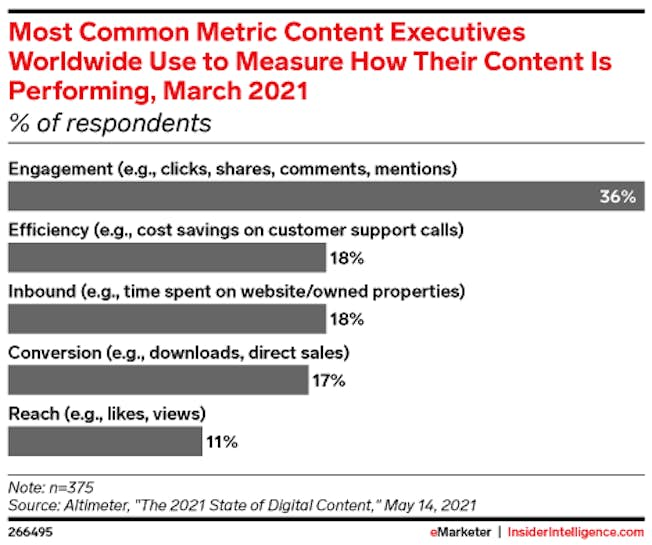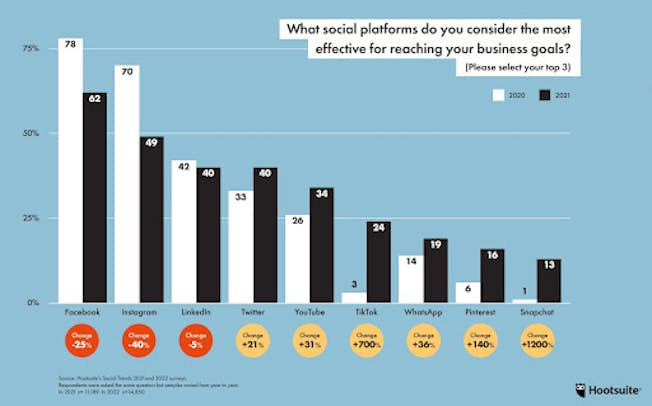As a digital or social media marketer, you need to be able to track and calculate your social media ROI (Return on Investment). It shows the value of your social campaigns in dollars, euros or yen so you can double down on the tactics that work and avoid those that don’t.
Social media is a powerful part of any marketing strategy to drive brand awareness and ROI and is growing in importance as shoppable posts and social commerce become a reality.
In this blog, we’ll show you how to measure your ROI and provide tips to improve it so you can boost the value of your social media activities.
What is social media ROI?
First of all, let’s define what social media ROI is. Like anything that refers to a Return on Investment, it’s the value of your social media activities divided by the investment made.
The formula to calculate ROI for social media is:
(return – investment made) / investment made X 100 = social media ROI
If your ROI value is more than 0 percent, you’re making money from your social media campaigns. Anything below that means you are losing money.
“34% of marketers said they were uncertain about their ability to measure the ROI of their social media marketing efforts ” Statista
How do you calculate social media ROI?
How you calculate ROI depends on the objectives of your organization and the metrics you use. You can download our social media campaign ROI calculator to keep track of your goals, costs and returns.
For example, is brand awareness a priority for your social media, or is it lead capture or sales? When creating your ROI metrics, bring them back to the objective and goal of your activities to prove value.
There are many social media goals you can choose. It really depends on your core objective, which could be:
- New followers
- Click-through rates
- Conversions
- Completed lead generation forms
- Downloaded files (e.g. eBook, whitepaper)
Common metrics to help measure social media ROI include:
- Engagement - as one of the most common and valuable metrics, engagement on social media shows the level at which people are interacting with your content and brand. Altimeter research found that over a third of content executives use engagement as a metric to gauge performance. Types of engagement metrics include clicks, shares, likes, and brand mentions.

- Reach - This metric is all about who sees and interacts with you on social media. It’s about audience size and shares, it looks at how far your social media content travels and is seen. It can be harder to measure than engagement as it only looks at how many people saw your post, but it’s important to track.
- Leads - Social media plays a role in lead generation and it’s important to know which channels provide leads and what content drives those leads. For ROI you want to be able to link your campaigns to activity so knowing your lead counts is useful to show performance.
- Conversions - When you put so much effort into your social media content and posts, it’s important to know at what level they convert. The easiest way to do this is to use UTM parameters on the links so you can track clicks by campaign and platform.
How do you track ROI for social media?
Once you select a goal or goals for your social media activities, you will need to set up a system for tracking your ROI.
- The easiest way to do this is to set a goal in Google Analytics. You can do this by setting up goals and event tracking. Read through our Google Analytics Goals Guide to understand all that’s involved and what you need to do.
- If you want to track other metrics - likes, shares and brand mentions - use a platform like Buffer or Ahrefs.
- If you’re new to Google Analytics watch this video to get a step-by-step guide on how to use it.
Note: Be aware that Google Analytics 4 has replaced Universal Analytics (which most marketers use), so make sure you’re up to speed with changes so you can account for them in your campaigns.
How can you assign money values to determine ROI?
The next step is to assign monetary values to calculate your social media ROI. The best way to do this is to use historical data. That way you can calculate the Lifetime Value (LV) of each customer. For example, if your average LV is $100 then that means 1 in 10 people who view your content become a customer. So the value of getting a visitor to convert is $10 ($100 divided by 10).
The other way to calculate monetary values is to estimate. This is not the more reliable way to do it but if you lack historical data. It’s the best place to start. Look at what your average purchase is through your site or what your PPC budget is for social ad conversions to determine a realistic value. This paid media budget forecasting tool may help you figure out costs.
How do you calculate social media spend or investment?
To calculate your social media ROI, you need to know how much you spend on creating and implementing campaigns. Examples of spend include:
- Your time or the time of your marketing team - it takes time and effort to set up campaigns, so account for the time spent on social media
- Tools or software - account for any software or tools you need to buy and pay for regularly
- Social ad spend - If you run paid social media campaigns, take your weekly or monthly budget into account
- Content creation - Social media requires content so account for any money required to create it
- External agencies - Do you use a copywriter or video content creator? Include the investment you make in your calculations
Tips to improve your social media ROI
No matter what your average ROI for social media is, there’s always room for improvement!
- Understand your audience - The key to ROI and social media success is understanding your audience. Make sure you know who is interacting with you and on what platforms so you can provide content that engages. If you don’t have ones developed, use this buyer persona template to create them today!
- Be clever with your content - It can be hard to get noticed on social media platforms with so much content out there. It’s about quality content, not quantity, so take time to create content that’s relevant, exciting and entertaining.
- Use social lead generation - In the U.S, marketers reported that social media accounts for 15 percent of their marketing budgets according to Statista data on social media budget share. This level of spend requires social media to generate leads and customers. So make sure you include lead generation forms on valuable content assets e.g. eBooks or online calculators to capture customer information.
- Test and optimize - Tweak and optimize your organic social posts using new imagery, keywords and headlines. On paid media try out new ad types and audiences to see the results.
For example, online furniture retailer Made used augmented reality ads on Facebook to boost sales and brand awareness. The immersive experience allowed people with iOS devices to position 3D virtual furniture in their homes. The campaign saw purchases increase by 2.5X, ad recall increase by 40% and 3X add to cart rate.

- Focus on your social media profiles - Remember that your profile is the first thing that people see when they come to your page. It’s your job to make a good first impression. Look at the images and content you’re using on every platform and optimize any bios or headers to convey what your brand does, in an instant.
- Use influencers - Across social media, influencers have power. For marketers, it’s all about finding an influencer that aligns with your brand and can drive brand awareness and leads. If you don’t have any ties to an influencer look at doing outreach to make connections. It’s not only for B2C brands either, influencers can be effective for B2B marketing so do a search and see what comes up.
- Keep an eye on social media and customer trends - Networks don’t stay the same year on year. As customers’ needs and behaviors change, so does their consumption of social media. Just look at Hootsuite’s Social Trends 2022 report to see the change in the effectiveness of platforms in achieving business goals from 2020 to 2021.

- Make sure to keep an eye on the latest social media trends to know where to invest your time and money.
- Keep the media in mind - A great way to get your social media campaign seen by a wider audience is to connect with the media. You can inform outlets by issuing a press release or tagging them in posts. This will help you to get backlinks or stories from the media especially if a campaign is about spreading awareness like for non-profits. The social media ROI metric for this could be ‘media mileage’.
Use Social Media to Drive Brand Awareness & ROI
As more customers use social media to browse, connect and purchase, marketers need to have social media know-how. Learn the fundamentals with DMI’s Professional Diploma in Social Media Marketing such as social research, social commerce, and social strategy. You’ll also get to grips with the ins and outs of the biggest social media channels including Facebook, Instagram, LinkedIn, YouTube, and TikTok.
Related
Upgrade to Power Membership to continue
your access to thousands of articles, toolkits, podcasts, lessons and much much more.
Become a Power Member- Login
- View Courses
- - - -
- Courses
- Resources
- - - -
- My Account
- Change Password
- Logout






